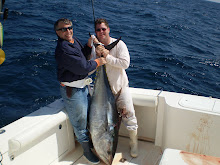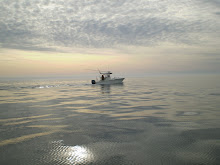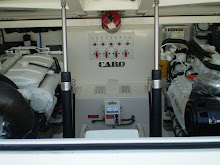During our last fishing trip this past Wednesday (post to follow), we were trolling in the vicinity of the Rockpile, in the company of a few other charter boats. One of these, Steve Wann pointed out to me, was the red-hulled Gambler, a highly respected charter boat that always seems to be in the money in big fishing tournaments. According to Steve, the Gambler is largely dedicated to catching marlin--that it's thing--and has quite a reputation on the docks. What's more, the boat itself is a converted lobsterboat, with lines characterized by a working house upfront and a longer cockpit that starts amidships.
Today I stopped by to see the Gambler upclose in its slip in Hatteras Harbor marina. Pictures as provided below. Most striking about the boat is its simplicity--nothing fancy and not a lot of gear showing. In the cockpit, just a fighting chair and two plastic chairs. On the bridge, a single narrow captain's chair, two teaser reels, and minimal electronics. You can clearly see its lobsterboat origins undergirding its current configuration as a Hatteras charter. Just goes to show: you don't need fancy to catch fish, you need knowledge, experience, and of course, a healthy dash of good luck. Everyone knows luck plays its part in fishing.
Finally, below the photos is an article from a local paper on the Gambler and its top-prize win in the Hatteras Village Offshore Open Fishing Tournament this past May.
Tucked between two larger Carolina boats

Her business card

Simplicity on the bridge

Lobsterboat in disguise--note the cabin windows/doors of the working house and elongated cockpit

Gambler takes top prize money in Hatteras Village Offshore Open
By IRENE NOLAN

The Hatteras charter boat Gambler, captained by Steve Garrett, took the top prize money in the 16th annual Hatteras Village Offshore Open Fishing Tournament. Fishing days were from Wednesday, May 12, through Saturday, May 15.
On the last day of fishing, Gambler boated and brought to the dock just before noon the largest blue marlin, a 530-pounder caught by angler Wayne Wray.
That gave the boat $29,750 for the largest blue marlin, $4,284 for third place in the Level 1 billfish competition and $4,624 in the Level 2 billfish competition.
Taking first place in the Level 1 and 2 billfish division was Waste Knot, which released two blue marlin and won total prize money of $22,270. Second place in those levels went to Qualifier with one white marlin and one blue marlin release for total prize money of $13,362.
Thirty-six boats fished in this year’s tournament, the first event in the North Carolina Governor’s Cup.
That is down from 47 boats last year and 51 boats in 2008.
On registration night, Tuesday, May 11, captains and anglers were speculating about why the number of boats in the tournament fell below the past few years.
The consensus was that it was a result of the economy and the fact that offshore fishing has not been at its best this spring because of unusually cold water offshore.
In fact, no tuna were caught in the meatfish division of the tournament, said the tournament chairperson, Beth Rooks.
Steve Garrett, the winning captain, said he was fishing 38 to 45 miles offshore to get to the Gulf Stream and good fishing conditions. Normally, he said, those conditions are about 25 to 30 miles offshore.
Garrett was fishing with a group of anglers from Roanoke, Va., and two mates – Dita Young and Darrin Callahan.
The captain said the Roanoke group usually charters his boat for the Big Rock Tournament, which is next month in Morehead City. The group that usually charters the Gambler for the Hatteras village tournament decided not to come this year, so Garrett called his Roanoke clients, who were only too happy to come to Hatteras for the tournament.
Other winners in the tournament were:
Gamefish division. Dolphin. First place of $4,080 to Impulse for a 39-pound fish. Second place of $2,720 for a 32.6-pound fish.
Gamefish division. Wahoo. First place of $4,080 to Release for a 39.7-pound fish and second place prize of $2,720 to Sea Toy for a fish weighing 34.4 pounds.
The entrants in the daily meatfish division split $13,175 in prize money. They were Impulse, Frequent Flyer, Sea Toy, and Brothers’ Pride.
The winners for daily marlin release points won a total of $14,450. They were Release on Wednesday with one blue marlin, Annie C on Thursday with one blue marlin, Wired Up on Friday with one white marlin, and Qualifier on Saturday with a blue marlin.
In all, anglers caught six white marlin, 13 blue marlin, and two sailfish. All but three of the blue marlin were released.
The tournament proceeds benefit Hatteras village non-profits and civic organizations.
























































